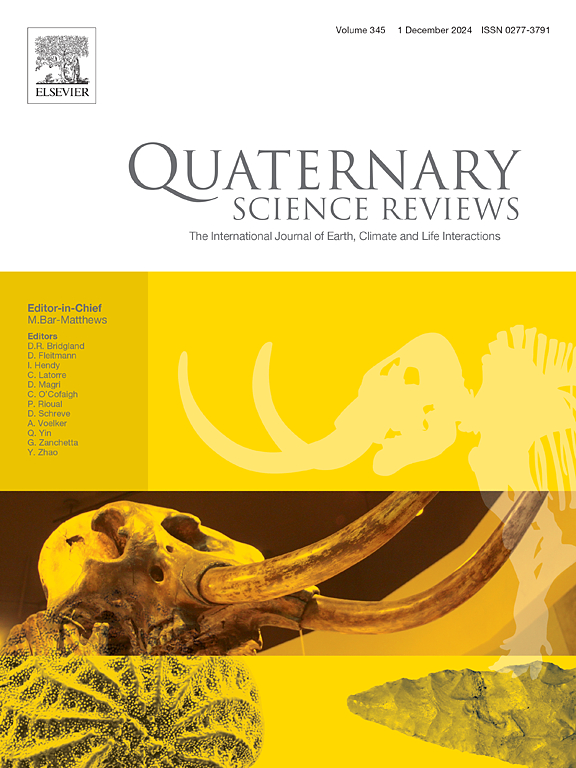Using New Zealand's late-Quaternary fossil record to estimate the past distribution and habitats of a relict species (kākāpō: Strigops habroptila)
IF 3.2
1区 地球科学
Q1 GEOGRAPHY, PHYSICAL
引用次数: 0
Abstract
New Zealand's (NZ's) endemic, flightless kākāpō (Strigops habroptila) – the world's heaviest parrot species - reached near-extinction due to human activity and predation by introduced mammals (51 known individuals between 1995 and 1996). Today, kākāpō only survive on managed predator-free sanctuaries (<250 individuals), and rarely breed except during mast events of native rimu trees (Dacrydium cupressinum). Here, we review NZ's Late-Quaternary fossil record in relation to palaeovegetation, and determine whether it can be used to identify the past habitats and distribution of kākāpō. First, we describe the distribution of kākāpō fossils from c. 25ka until the present and the former habitat breadth of kākāpō. Second, by comparing the abundance of kākāpō fossils to those of similar-sized landbirds in each site, we identify how past kākāpō abundance was affected by habitat type. Although we identify that kākāpō exhibit strong taphonomic biases, we show that kākāpō are the fourth-most common bird taxon in NZ's late-Quaternary deposits (1351 Minimum Number of Individuals from 274 sites), and occupied all forests and adjacent habitats, on the NZ mainland prior to human settlement ca. 0.8 ka. However, we find little evidence that kākāpō occupied semi-arid shrublands, the high alpine zone, or most grassland/shrublands during glacial periods. Further, kākāpō were most abundant in humid, high precipitation forests, were rarest in drought-prone, low-rainfall scrub/forests, and were common in many rimu-free habitats. We also determine that contemporary kākāpō occupy a small proportion of their optimal habitat range. Our study demonstrates the value of late-Quaternary (ca. 50 ka to present) fossils for conservation biology and reveals how contemporary data alone can underestimate the habitat breadth of previously more widespread species.
利用新西兰晚第四纪化石记录估计一种遗存物种(kākāpō: Strigops habroptila)的过去分布和栖息地
新西兰特有的不会飞的kākāpō (Strigops habroptila)——世界上最重的鹦鹉——由于人类活动和被引入的哺乳动物捕食而濒临灭绝(1995年至1996年间已知有51只)。如今,kākāpō只生存在有管理的无捕食者保护区(<;250只),很少繁殖,除非在本地木(Dacrydium cupressinum)的高峰期。在此,我们回顾了新西兰的晚第四纪化石记录与古植被的关系,并确定它是否可以用来确定kākāpō过去的栖息地和分布。首先,我们描述了从c. 25ka到现在kākāpō化石的分布和kākāpō以前的栖息地宽度。其次,通过比较每个地点kākāpō化石的丰度与相似大小的陆鸟化石的丰度,我们确定了过去kākāpō丰度是如何受到栖息地类型的影响的。虽然我们发现kākāpō表现出强烈的地学偏差,但我们发现kākāpō是新西兰晚第四纪沉积物中第四大常见鸟类分类群(来自274个地点的1351个最小个体数),并且在人类定居前约0.8 ka占据了新西兰大陆所有的森林和邻近栖息地。然而,我们发现很少有证据表明kākāpō在冰期占据半干旱灌丛地、高寒带或大部分草地/灌丛地。此外,kākāpō在潮湿、高降水的森林中最丰富,在容易干旱、低降雨的灌丛/森林中最罕见,并且在许多无riam栖息地中很常见。我们还确定当代kākāpō占据了其最佳栖息地范围的一小部分。我们的研究证明了晚第四纪(约50 ka至今)化石对保护生物学的价值,并揭示了当代数据如何低估了以前更广泛分布的物种的栖息地宽度。
本文章由计算机程序翻译,如有差异,请以英文原文为准。
求助全文
约1分钟内获得全文
求助全文
来源期刊

Quaternary Science Reviews
地学-地球科学综合
CiteScore
7.50
自引率
15.00%
发文量
388
审稿时长
3 months
期刊介绍:
Quaternary Science Reviews caters for all aspects of Quaternary science, and includes, for example, geology, geomorphology, geography, archaeology, soil science, palaeobotany, palaeontology, palaeoclimatology and the full range of applicable dating methods. The dividing line between what constitutes the review paper and one which contains new original data is not easy to establish, so QSR also publishes papers with new data especially if these perform a review function. All the Quaternary sciences are changing rapidly and subject to re-evaluation as the pace of discovery quickens; thus the diverse but comprehensive role of Quaternary Science Reviews keeps readers abreast of the wider issues relating to new developments in the field.
 求助内容:
求助内容: 应助结果提醒方式:
应助结果提醒方式:


